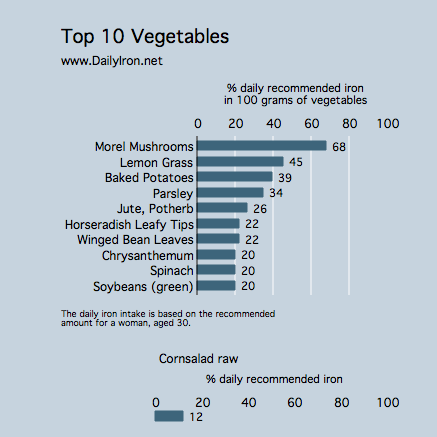Cornsalad contains 2.1 milligrams of iron per 100 grams. Grams is a measure of weight. To put 100 grams in perspective, consider alternative measures for this food:
- 1 cup equals 56 grams.
In the category of vegetables, we included whole vegetable products in the Top 10 list. We excluded dried/dehydrated products from the Top 10. You will find some dehydrated vegetables high in iron per 100 grams,but they tend to be far more volume than anyone would consume. Furthermore, foods may be fortified with iron but are not included in this Top 10 list. The food tested for the particular graph below can be described more specifically as:
Cornsalad, raw
Read more about iron in vegetables or visit our iron-rich foods list.

Vegetables overall are not an exceptional iron source. Those vegetables that do have a lot of iron also are likely to be packed with substances that inhibit iron, making it difficult to absorb much of the iron from the vegetable itself.
On the other hand, even a vegetable with modest amounts of iron may play a significant part in your body’s ability to absorb iron. Vegetables often times are high in vitamin C and vitamin C can help you assimilate the iron better in your vegetarian foods; cornsalad is rich in vitamin C.
For example, you can incorporate vine ripened tomatoes and bell peppers with a whole grain entree or with a bean recipe to improve your digestion of the iron in your entire meal. A fresh mango salad with a meal would help as well because of the fruit’s content of vitamin C. A glass of fruit juice is one more an effective plan.